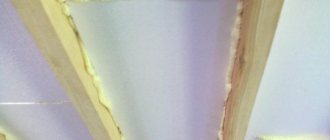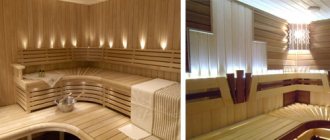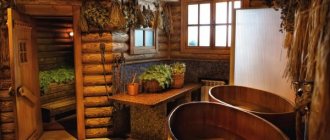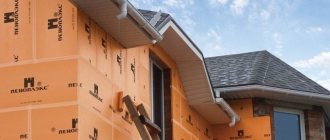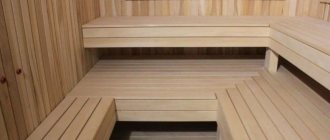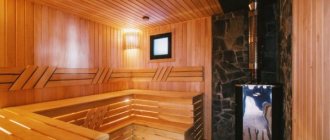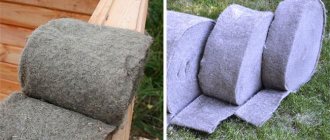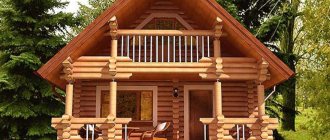Vapor barrier of a bathhouse is a prerequisite when arranging walls and ceilings. In most cases, aluminum foil is used for this, which has many advantages over other types of materials. Such a layer will be able to protect the walls from excess moisture, retain heat and withstand high temperatures, which increases the level of fire safety. Installation features are determined by the functional properties of the bathhouse and the arrangement of the walls themselves.
Foil materials: structure and principle of operation
Even people far from construction have at least once encountered insulation that is shiny on one side; the name of one or another of its varieties is known to owners involved in construction or repair. Such materials are often called two-layer, because of the conspicuous metal (reflective) layer; There are options coated with a reflective layer on both sides.
The bottom (or inner) layer is made of a porous or fibrous material. It serves as thermal insulation and serves as a strong base for the foil. The foil component, glued on top of the insulation, is needed to reflect infrared (thermal) radiation. It is made of aluminum foil or metallized film, different in properties:
- Aluminium foil . It is applied by heat welding and polished to the desired reflectance (95%). The foil is destroyed by the salt contained in the cement mortar.
Foil retains heat in the room Source otoplenie-gid.ru
- Metallized film . Apply to one or two sides of the material. It reflects less heat, but is resistant to alkaline influences.
Each layer has its own “responsibilities”. The foil reflects thermal energy, and does it effectively: according to manufacturers, up to 90-95% of thermal radiation is returned. The remaining percentage is partially absorbed by the insulation, and partially the heat is dissipated in space.
Attention! Practical measurements have shown that the efficiency of foil thermal insulation is 30-60% higher than that of a similar single-layer thermal insulation material. It is important that the price difference is not so significant; In the long term, this means savings on heating.
Foil underfloor heating reduces heat loss Source veralline.com
Vapor barrier isospan technical characteristics
- The material is waterproof;
- Elasticity is beyond praise; it is not difficult to get around the most difficult areas and bends;
- Resistance to ultraviolet radiation;
- Resistance to negative atmospheric phenomena;
- Does not emit harmful substances. Safe for human health. Does not harm the environment.
- Withstands temperature changes in the range from – 60 °C to + 80 °C
- Fireproof elements added in production determine the fire hazard group G4, which is confirmed by relevant certificates.
Izospan has various applications, taking into account the field of construction use. Isospan, a type of insulation unique in its structure, has individual technical characteristics and its own labeling.
Manufacturers classify their products by letter indices A, B, C, D, F, R. The combination of letter indices adds numerous variety, applications and installation of isospan. Each new designation assumes its own isospan application. This fact must be taken into account when building your home.
roof vapor barrier isospan
Pros and cons of reflective insulation
A wide range of applications makes shiny insulation in demand; what this or that variety is called and where it is used depends on the composition of the layers. Foil-based materials are designed to protect ceilings, floors and walls; They are used to insulate pipes and roof vaults. Widespread use is possible thanks to properties, some of which are unique to them:
- High efficiency . A shiny coating allows only 5-10% of heat waves to pass through, the rest are reflected back.
- Hydro- and vapor barrier . The metallized layer is irresistible to atmospheric moisture and steam. This property is actively used in the construction of baths and saunas.
- Easy installation . The material is secured with a stapler or nails; some varieties are made on a self-adhesive basis. Insulation with foil is flexible and easy to install on complex shaped surfaces.
Forming a gap for ventilation Source world-comfort55.rf
See also: Catalog of companies that specialize in insulating houses
- Long-term operation . Achieved with proper installation. The insulation will not become moldy, and the metallized layer will not collapse.
- Safety . Reflective thermal insulation materials are non-toxic to humans.
The disadvantages include the following features:
- Thermos effect . It occurs as a result of the circular use of foil material in violation of installation rules, and provokes the appearance of mold. The problem is not always solved with ventilation.
- Terms of Use . Concrete is a bad neighbor for aluminum foil; the salts it contains corrode the metal layer within a year.
- Thermal conductivity . The heat-reflecting layer, like any metal, heats up, due to which some of the energy is lost.
Wall mounting Source pechiexpert.ru
Types of reflective insulation
For owners who have started construction or renovation, it is not indifferent to the name of the insulation, on one side of which foil is glued, since not all varieties are interchangeable. It is equally important to understand how to properly install insulation with foil in order to minimize heat loss. There are several types of thermal insulators with foil on the market, with different thermal insulating material as a base.
Foamed polyethylene (polyethylene foam)
The material looks like an elastic fabric 2-10 mm thick, structurally consisting of closed-porous cells. Insulation is sold in rolls; some manufacturers supply it with a self-adhesive base; The reflective layer is aluminum foil.
Polyethylene foam with foil is suitable for thermal insulation of the floor, where it is placed under the final finish (for example, laminate). For heating radiators, thin varieties of fabric are chosen as a reflective screen. Elastic material is suitable for insulating water and sewerage pipes; it will keep the pipes from freezing and at the same time protect the owners from annoying noise.
Insulation made of foamed polyethylene Source of peace-comfort55.rf
Izospan S
The structure of the material combines two layers: on one side there is a smooth surface, on the other there is a fleecy surface. The fleecy layer retains condensation followed by weathering. Izospan C creates a vapor barrier for the insulation, preventing the absorption of vapor from water particles formed inside the room.
The material is widely used in the construction of walls, installation of insulated, sloping roofs and interfloor ceilings. Steam-waterproofing using type C is installed in various cement screeds and in flat roof structures.
In a word, in structure and characteristics the material is very similar to type B. At the same time, it has an increased margin of safety and, therefore, the reliability of the super-dense panel is higher. Buying isospan C will cost the consumer about 50-60% more than type B.
Characteristics of isospan Type C:
- 100% polypropylene;
- Applicable temperature range -60 – +80 °C;
- Tensile load: longitudinal // transverse. N//5cm not less than 197/119
- Vapor-tight
- water resistance not less than: 1000 mm water column.
Application of isospan S:
- Sloping roof with an overlap of at least 15 cm
- Attic floor protection. A vapor barrier layer is spread on top of the insulation, smooth side down;
- Concrete floor. spread on a concrete surface, smooth side down;
- Wooden floors of horizontal design.
Laying the canvas on sloping roofs should be done from bottom to top. The material overlaps about 15 centimeters.
To avoid depressurization, overlapped joints are glued together with a special tape that is sticky on both sides, similar to double-sided tape.
The structure is secured with slats 5 cm thick. A gap of at least 5 centimeters is left between the roof tiles and the vapor barrier layer; it is necessary for natural ventilation.
Izospan C is spread on top of the insulation; for ventilation it is necessary to leave a gap of about 50 millimeters from the panel to the heat-insulating material. In the installation of a concrete floor, type C, an overlap is laid on the concrete surface, then a cement screed is laid on the canvas, and only after that the floor covering is installed.
Features of installation of foil insulation
Before purchasing, measurements are taken and the required quantity is calculated based on the fact that the insulation will be fixed not overlapping, but end-to-end. The question of how to properly lay insulation is solved in the same way for both types of metallized coating. When insulating walls, adhere to the following rules:
- Foil thermal insulation is laid with the reflective (shiny) side inside the room.
- Double-sided material is intended for thermal insulation of frame buildings.
- Installation on walls includes the organization of sheathing, the slab insulator is fixed in it between the guides and is additionally strengthened with dowels.
- Installation on the ceiling is carried out using a stapler. The joints are sealed with metallized tape or aluminum adhesive tape. Between the insulation and the final finish, a gap of 2-2.5 cm is created for ventilation.
Fixing joints Source krovlyaikrysha.ru
Briefly about the main thing
Reflective insulation works according to a special principle based on a layer structure. The main layer consists of a porous or fibrous material; on top (sometimes on both sides) it is complemented by a layer of aluminum foil or metallized film.
It is the shiny surface that does the main job of retaining heat in the room. Additionally, it serves as a steam, hydro and sound insulator, and if the installation technology is violated, it causes the appearance of a thermos effect.
Common foil materials include polyethylene foam, basalt and glass wool, and foil polystyrene foam. To fix the material on the surface, you need a stapler or dowels; the joints are fixed with aluminum adhesive tape.
Ratings 0
Installation technology
Most often, vapor barrier materials with foil are used to equip a cold attic and a warm attic. In the first case, the insulation system must be installed along the ceiling, in the second - along the slopes.
To install a vapor barrier correctly
, you need to adhere to generally accepted construction rules:
It is worth noting that accessories for foil insulation must be selected from the same manufacturer as the material. Of course, you can find universal tape on sale that is suitable for joining materials of any kind, but in the case of foil structures, you need to remember about tightness. Therefore, here it is better not to experiment with options for adhesive tape for gluing, but to take it from the same company that produces the foil sheets themselves.


